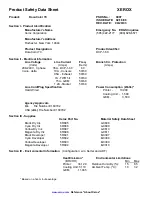
428
SEP 2004
Ver. 1.2
DP-1520P/1820P/1820E
9.3.4.
Router
Routers, operating at the OSI Network layer, organize the large network in terms of logical network
segments. Each network segment is assigned an address so that every packet has both a destination
network address and a destination device address.
Routers are more intelligent than bridges. Not only do routers build tables of network locations, but they
also use algorithms to determine the most efficient path for sending a packet to any given network by
identifying its header information.
These are the typical functions:
1.
Routing
This controls the traffic according to a specified routing table.
2.
Packet Filtering
This performs the access and security control for specified routing.
3.
Address Conversion
NAT (Network Address Translator), This performs conversion of a single global IP Address from/to
single private IP Address.
4.
IP Masquerade:
This performs a conversion of single global IP Address from/to multiple private IP Address.
At the same time the port number is automatically assigned.
Occasionally, the conversion creates a bottleneck in the network overhead. For a typical solution, PIX
(Private address Internet address exchange) is available from Cisco, which is a well-known
manufacturer.
5.
Designated Reply
These are reply that keep a connection alive by responding with a signal periodically.
Watch Dog in IPX/SPX, TCP/IP in TCP, and Net BT (NetBIOS on TCP/IP) in Windows NT are all well
known techniques to keep a live connection.
PC-A
192.168.32.1/24
Router B
PC-B
192.168.32.2/24
PC-C
192.168.33.1/24
PC-D
192.168.33.2/24
access-list permit tcp 192.168.32.0 0.0.0.255 192.168.33.1 0.0.0.0 eq 23
OK
OK
permission denied
permission denied
192.168.32/24
Packet Filtering Sample
192.168.33/24
Summary of Contents for Workio DP-1520P
Page 98: ...98 SEP 2004 Ver 1 2 DP 1520P 1820P 1820E DETAIL A 28 35 31 32 33 34 30 29 ...
Page 464: ...464 SEP 2004 Ver 1 2 DP 1520P 1820P 1820E memo ...
Page 495: ...memo ...
Page 496: ...DZZSM00257 ...
















































